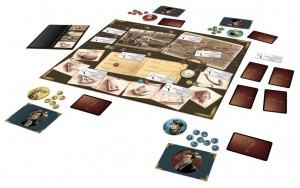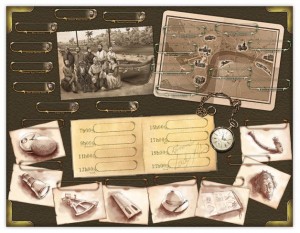Review: Lady Alice
Posted by James (admin) on July 14th, 2013
 In Lady Alice, players are the kids on Baker Street who are trying to solve the kidnapping of explorer Stanley with Sherlock Holmes’s guidance. With that said, you’ll be unsurprised that Lady Alice is a deduction game.
In Lady Alice, players are the kids on Baker Street who are trying to solve the kidnapping of explorer Stanley with Sherlock Holmes’s guidance. With that said, you’ll be unsurprised that Lady Alice is a deduction game.
A crime has been committed and there are 4 pieces of information (categories) to work out: Where, Who, When and What. There are 8 different possibilities (clues) in each of the 4 categories (and there’s a card for each of the 32 clues). In the middle of the table is a board which shows Sherlock Holmes’s desk where all of the clues are displayed. (I’ll describe how the game plays with 4 players as it’s the most straightforward.)
At the start of the game, one card from each of the 4 categories is randomly drawn face-down – these 4 cards are the solution to the crime which are shuffled up and each player is dealt one at random. So, each player holds one of the 4 pieces of evidence and players don’t even know which category each of the other players holds.
Each round breaks into two phases. In the first phase, the player whose turn it is declares a ‘suspicion’ by picking one location, one time, one person and one item. The game comes with a cool spiral-bound notebook so the player can flip over each of the different clues in different mixtures until the 4 clues that comprise their suspicion are displayed.
Each player then secretly places a ‘Yes’ or ‘No’ card in their envelope. If the evidence card a player holds matches any of the clues in the proposed suspicion, they place a ‘Yes’; otherwise, they place a ‘No’. The envelopes are shuffled so no-one knows which envelope is from which player and they are then revealed showing how many say ‘Yes’ and ‘No’. If they all say ‘Yes’ then the correct solution has been discovered, the game ends and the scores are added up to determine the winner. If all the envelopes say ‘No’ then all of the clues in the suspicion can be eliminated from the investigation as no player holds any of those evidence cards – this is done by placing Sherlock Holmes’s business cards over each of the relevant elements on the board.
Most likely, there will be a mix of ‘Yes’ and ‘No’ results which gives some information about the correct solution to the crime. As each player holds one piece of evidence, each player may gain different information to the other players. If you include the evidence you hold in your suspicion, then you know if only one ‘Yes’ is shown then that was your ‘Yes’ and you can eliminate the other items; whereas, other players can not.
After the suspicion phase, the second phase begins where players take turns taking one action until everyone passes. An action can be to either (a) place a deduction counter, (b) make an accusation, or (c) pass.
Each player starts with 9 deduction counters in their colour which each have numbers on one side (3 zeroes, 3 ones, 3 twos). As their action, a player can place a deduction counter face-down next to any one item on the board. If these items are part of the correct solution, then the player will score the number of victory points (VPs) on their counter. If you place a clue where someone has already placed a counter, you get to flip their deduction counter face-up and reveal what value they placed. The zero-value counters are good to sow false trails and mask your own activity.
Making an accusation is the same process as stating a suspicion, i.e. players place Yes/No cards in their envelopes. However, if any show ‘No’ then the accusing player is effectively out of the game; so, you need to be fairly certain your accusation is correct.
Once every player has passed in succession, a new round begins and the next player declares a suspicion. The game is played until a suspicion or accusation shows all ‘Yes’ results. When this happens, VPs are scored for deduction markers next to the correct items. Also, making a correct suspicion scores 1 VP, making a correct accusation scores 3VPs, and having a value-1 or value-2 deduction marker next to a correct element in each category scores 2VPs. The player with the most VPs wins.

Overall, Lady Alice can start out sounding a little like Clue/Cluedo, due to the proposing of different elements in a suspicion (and, for me, that’s a bad thing); however, Lady Alice has much more to it so it feels nothing like Clue/Cluedo. Making suspicions and seeing the result is interesting as all players try to work out what information they have gained from it (and what other players may have gained too).
The deduction markers are a very important game mechanic which really add to the game. Not only do you want to place them on the correct locations to score VPs, but you also want to use them to feed other players misinformation. Also, you want to be subtle about placing them and place them late in the game so other players are not tipped off, but you don’t want to place them too late when there’s no room left as only a fixed number of counters can be placed next to each item. Turning over the deduction counter ahead of one that you place is a nice addition and delivers extra information about what players are up to.
I like that the winner may not necessarily be the player that makes the correct accusation as it’s the total VPs that count. Making a correct accusation scores 3 VPs which is a lot so there is still a great incentive to do so, but it’s not the only route to winning.
The cards used to cover-up items which all players know have been eliminated (i.e. when all ‘No’s are revealed for a suspicion or accusation) are helpful and track what is common knowledge. However, I think it’s essential to use notepads too to help you keep track of what you know. A mix of Yes/Nos are revealed for most suspicions and these can be tough to track after a few rounds as they eliminate clues, or maybe only eliminate specific combinations of clues. Also, you may want to track which players proposed which clues as you know players are likely to include their own piece if evidence in their suspicions as that’s likely to give them extra information. Plus, you may also want to track what you’ve declared as suspicions too so you track what your suspicions tell others.

The only downside to the game I found was that a couple of the clue categories are not as visually clear as they could be. For example, the suspect’s faces and names which are large on the cards are very small on the board (both in the group photo and next to the deduction marker areas) so it’s hard to quickly see which deduction markers relate to which person. I really like the visually thematic board, so I wouldn’t change that, but the excellent group photo could have been placed better to give more clarity. For example, the photo could have been much larger with the non-vital areas tucked underneath neighbouring items and the deduction marker areas around the edges connected by lines to the relevant person – this would have removed the need for the extra images of their faces and made it easy to see who was who at a glance. The locations had a similar but lesser problem. (The time and objects did not have this issue.) However, this is a very minor problem and doesn’t affect the gameplay.
Playing with 5 players has a slightly different set-up as one extra piece of evidence from a random category is dealt out, i.e. there could be one place, one person, one object and two items, but no-one knows which category is represented twice. In this case, a correct solution simply needs 4 Yes cards. Similarly, with 3 players, a random piece of evidence is removed from the 4 before they are dealt out so no-one knows which category is missing from the solution and a correct solution requires just 3 Yes cards.
In the end, I really enjoyed Lady Alice and I found it best when I had a notepad to keep track of things. Deduction games are difficult to design as they must deliver the correct balance of uncertainty, logical elimination and individual knowledge, and Lady Alice does these well. There’s a great sense of anticipation when the results of each suspicion are revealed and players are eager to get to the next suspicion to find out more. Plus, there’s a real sense of a race to be the first to get the solution right, as well as a fun amount of banter amongst the player which include further various truths, lies and misdirection.
James.
[Played with 4 and 5 players]

